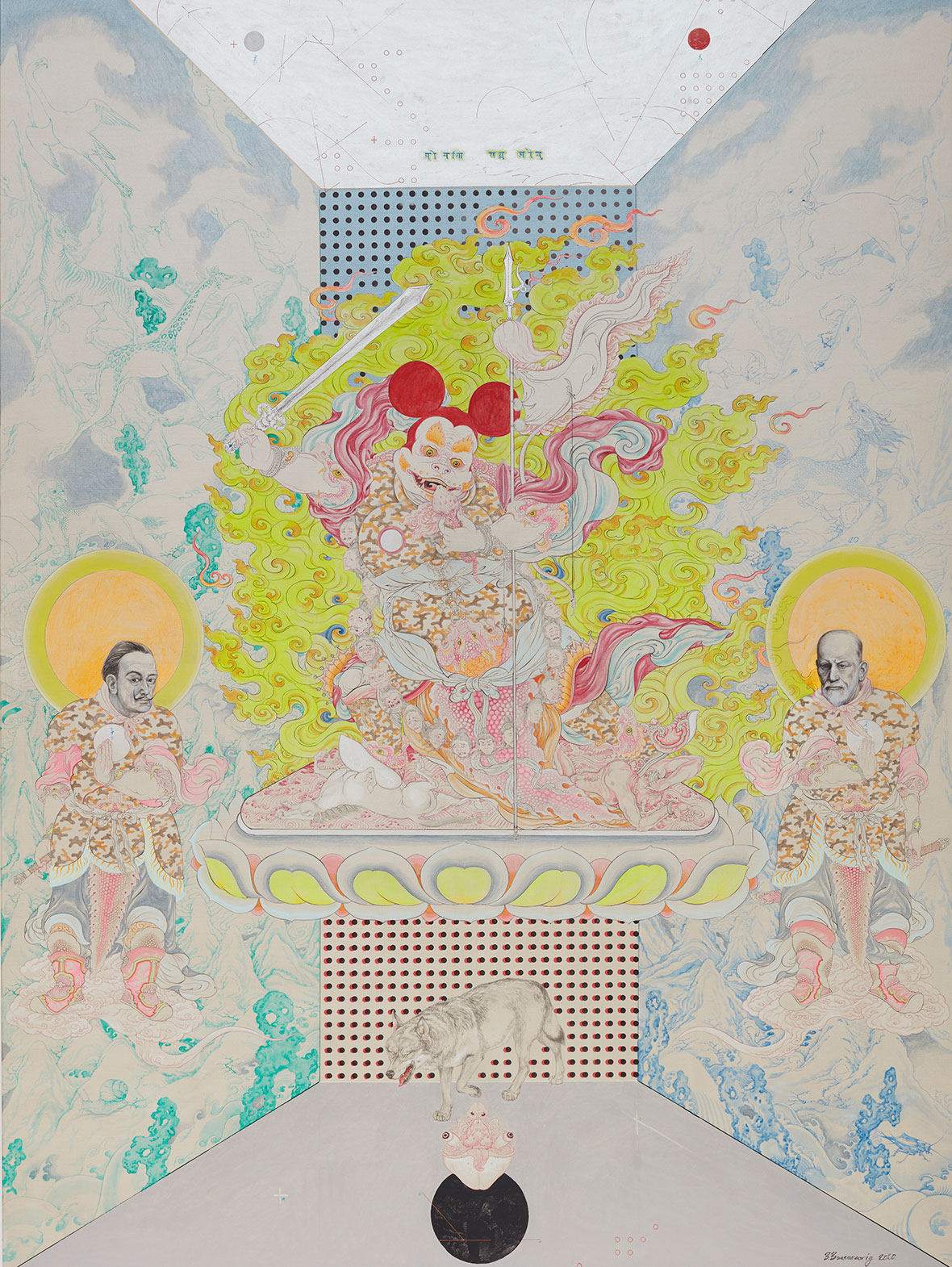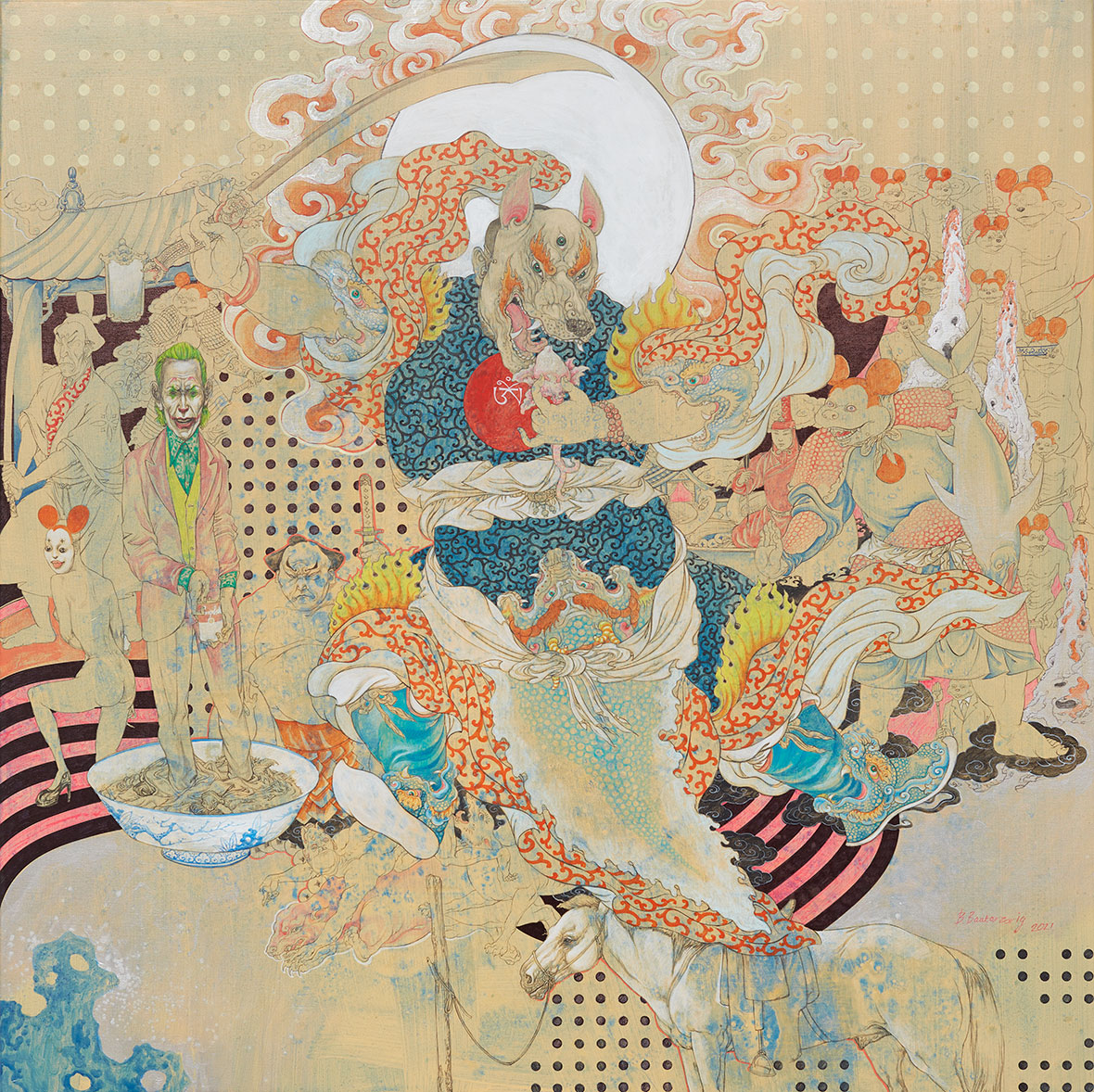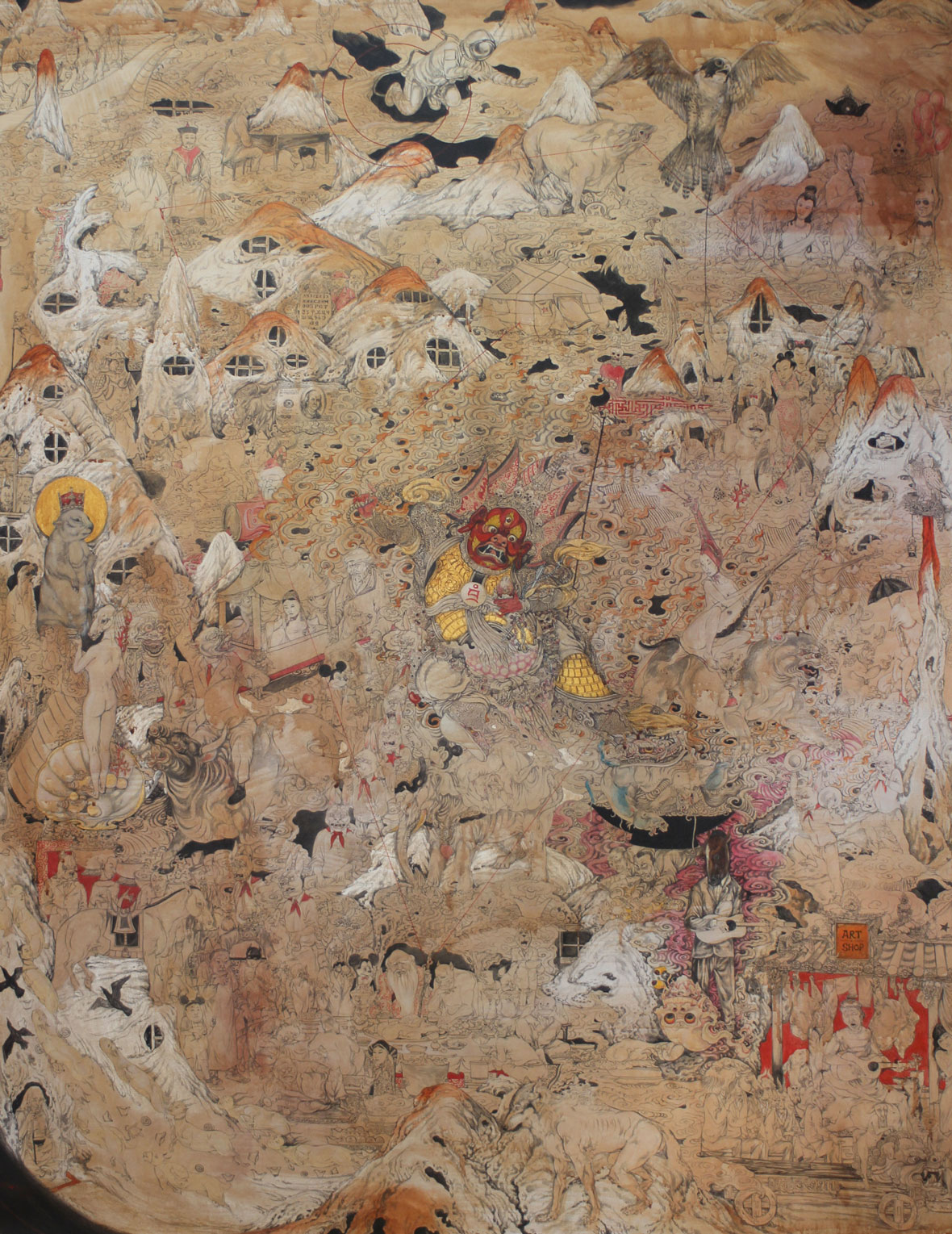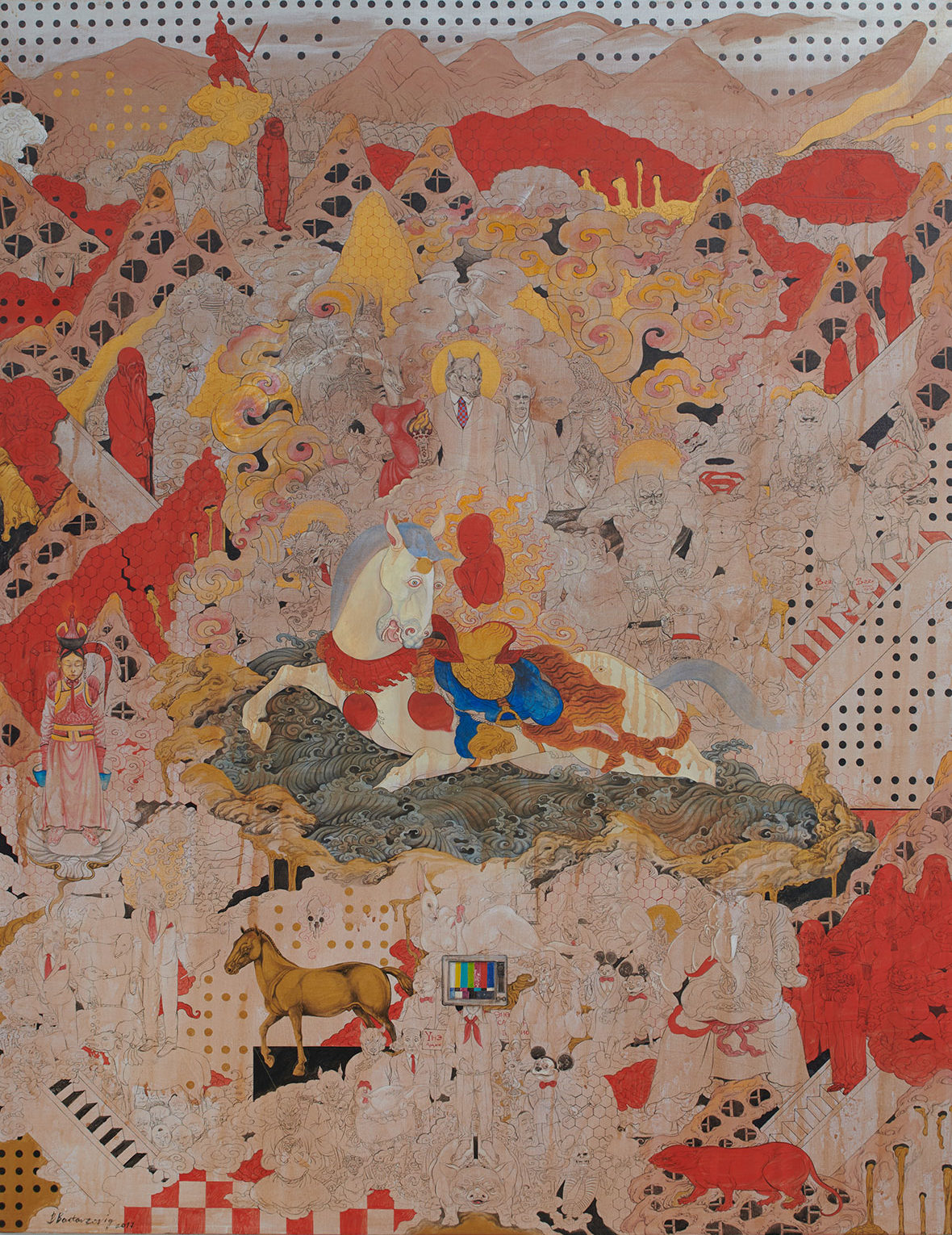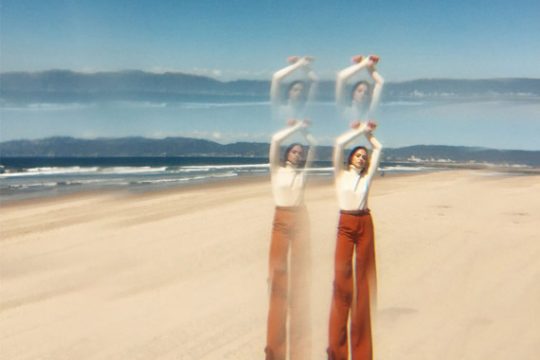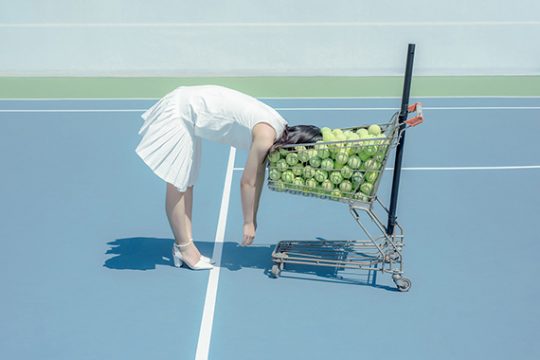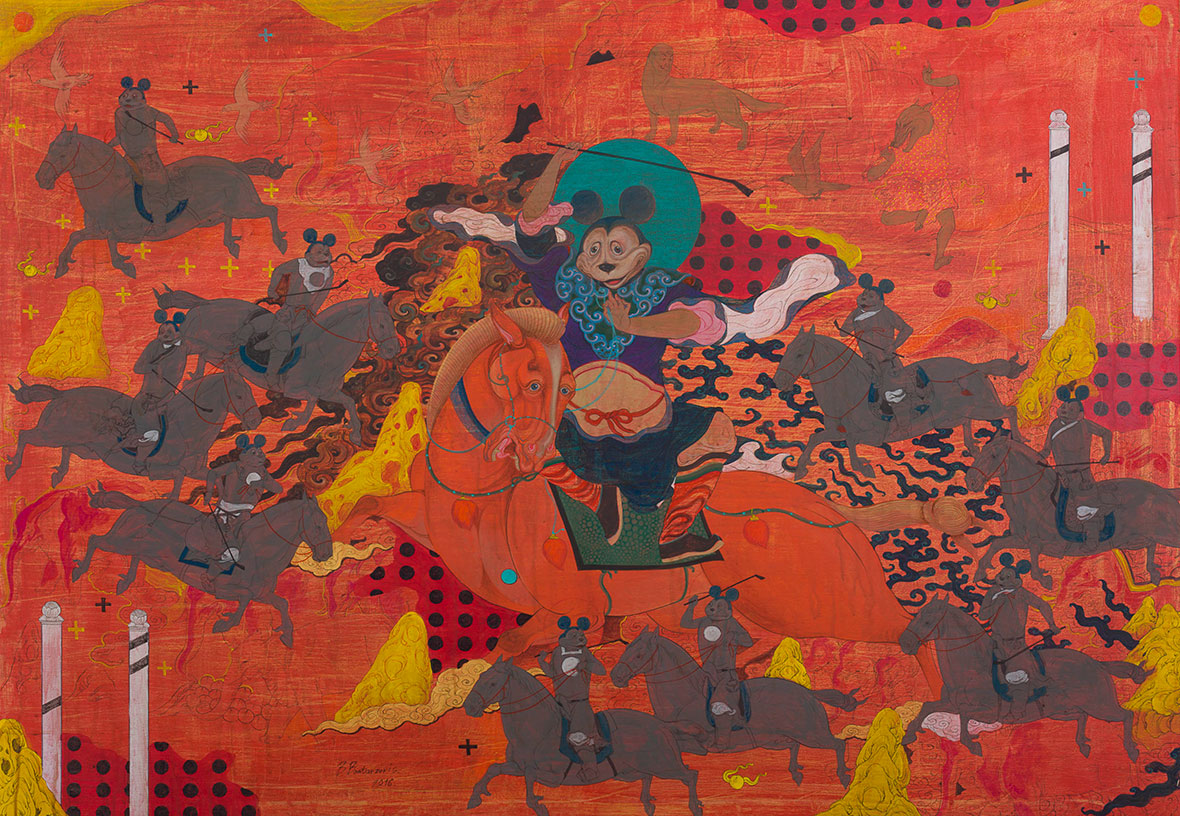
Some 800 years ago, Mongol warrior Genghis Khan united the nomadic tribes of the Mongolian plateau and formed the largest land empire the world has ever seen, the Mongol Empire. Interestingly, the Mongol Empire was mainly composed of nomadic people who, according to the season, moved around carrying their traditional yurts—rounded white tents that could be assembled in roughly two hours—and the livestock that provided them with warm clothes and sustained their mostly dairy-based diet. Even with changes in rulership, civil wars, and the influence of foreign religions, their lifestyle remained unchanged and was passed down through generations. The nomadic culture was still prevalent in Mongolia until the early 20th century, when everything changed.
大约在 800 年前,来自蒙古的武士成吉思汗统一蒙古高原的游牧部落,建立了当时世界上最大的帝国——蒙古帝国。蒙古帝国主要由游牧民族组成,他们往往会根据季节变换,携带蒙古包(圆形的白色帐篷,可在约两个小时内组装好)四处游牧。与之同行的还有他们的牲畜,这些牲畜可为他们提供保暖的衣物,维持他们以乳制品为主的饮食习惯。在此之后,即便受到来自政权更替、内战或是外国宗教的影响,他们始终保持着相同的生活方式,代代相传,游牧文化也一直在蒙古盛行。但这一切从 20 世纪初,开始快速改变。
“We’re losing our heritage at a grand scale that I find heartbreaking. Now Mongolians are following the direction the world is going. In the city, everything is standardized, from apartment buildings to the means of transportation—our traditions and nomadic culture conflict with this modern lifestyle. It’s almost as if heritage is something to be displayed only in a museum,” says Ulaanbaatar-based multimedia artist Baatarzorig Batjargal.
Batjargal expresses his concern with the rapid disappearance of the nomadic culture and other Mongolian traditions through large and colorful paintings, which he populates with a myriad of characters, including animals, historical and religious figures, and pop icons. Each with its own symbology, these figures represent the different forces that defined the complicated recent history of his country. To get to know his characters and the symbology behind them is to understand the history of Mongolia over the past one hundred years.
“蒙古传统文化正急剧消逝,我感到难过。现在的蒙古人正追随着世界发展的步伐。在城市里,从公寓楼到交通工具,一切都在标准化。我们传统和游牧文化与现代生活方式相互冲突,仿佛文化传统只适合摆放在博物馆中展示,”来自乌兰巴托的多媒介艺术家 Baatarzorig Batjargal 说。
Baatarzorig 通过色彩丰富的大幅画作,表达自己对游牧文化以及其他蒙古传统文化正在消逝的担忧,画面中布满各种带有象征意义的动物、历史和宗教人物以及流行偶像,分别代表了影响蒙古近代历史的不同分支。了解其作品中的角色及其背后的象征意义,也是在了解蒙古过去一百年的历史。
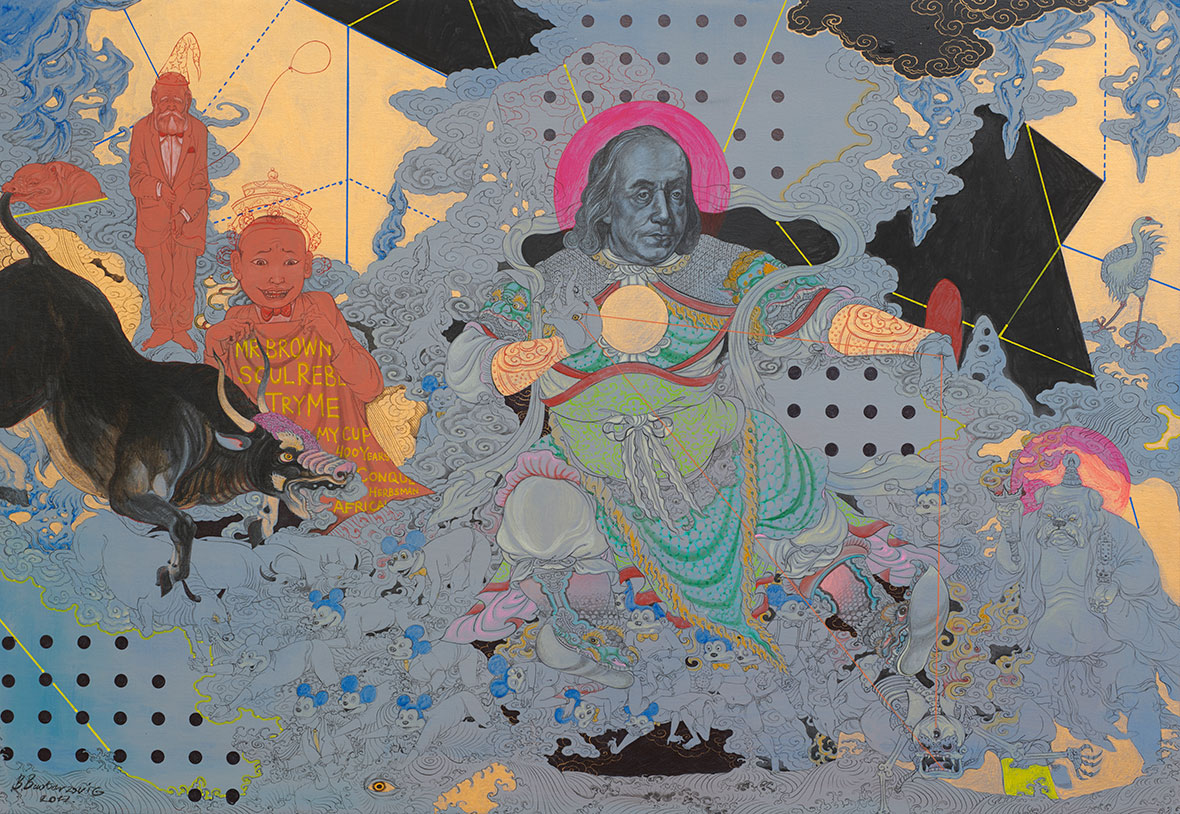
Perhaps the most symbolic thing about his work is the style he paints, the Mongol zurag, a folk style that relates intrinsically to Mongolia’s ancient traditions and the culture of the nomadic people. As it’s typical of contemporary zurag, Batjargal’s works can look ancient at first glance. They almost invariably depict Mongolia’s mountainous landscape and show flattened perspectives, traditional patterns, and a rich iconography reminiscent of wall paintings and Tibetan thangkas. We see many shamanic and Buddhist deities, warriors, and the ultimate symbol of mobility for nomadic herders, horses.
However, a closer look reveals seemingly disconnected elements that almost feel like intruders in the scene: frightening mice with Mickey Mouse ears, tie-wearing predators, deities in superhero costumes, astronauts, and famous personalities like the Joker, Freud, Dalí, and Benjamin Franklin. The latter appears in Batjargal’s work exactly as he does in the American hundred-dollar bill.
“If I speak about each element that appears in my works, it will take a long time,” Batjargal laughs. To sum up, he depicts “characters from the past, present, and future, which coexist in a single space. The past comprises myths, rituals, tengerism, shamanism, and wild creatures; the present is represented by characters such as Mickey Mouse, wolfs, and rabbits; and the future is shown with the presence of technology and its advancements,” he explains.
在他的作品中,最具象征意义的莫过于其绘画风格——蒙古祖拉格(zurag)绘画。祖拉格风格来自民间,与蒙古的古老文化传统及游牧民族文化有着千丝万缕的脉络联系。Baatarzorigl 的作品正是当代祖拉格风格的典型代表,乍看之下,传统气息扑鼻而来。他的作品经常以扁平的视角描绘蒙古的山野景观、各种传统图案和丰富的意象,令人想起壁画和西藏唐卡作品。画中描绘了萨满教和佛教神灵、武士、游牧民以及各种马匹。
然而,仔细观察下,你还会发现画中很多看似格格不入的元素,如同场景中的外来入侵者——譬如长着米老鼠耳朵的老鼠、戴着领带的捕食者、穿着超级英雄服装的神灵,以及宇航员、小丑、弗洛伊德、达利和本杰明·富兰克林等名人,其中本杰明·富兰克林更是以百元美钞上的样子出现在 Baatarzorigl 的作品中。
“如果我逐一解释我的作品中出现的每个元素,那估计得花很长的时间,” Baatarzorig 笑着说道。但简单来讲,他描绘了 “关于过去、现在和未来。过去,包括神话、宗教仪式、旅游、萨满教和野生动物;现在,则是米老鼠、狼和兔子等;而未来,则在科技和发展论上体现。”
Batjargal chose the zurag style because it stems from the same pictorial tradition of old Mongolian paintings, with no limitations of time and space, allowing for a multilayered expression with many perspectives and meanings. He’s part of a movement of Mongolian artists that uses the zurag to express their sentiments of confusion facing the social and political changes the country went through over their lifetimes, notably the problematic transition from communism to capitalism.
Mongol zurag translates literally to “Mongol painting.” It developed at the beginning of the 20th century as a secular art form, marked by the depictions of figures and scenes of daily earthly life. One of the first pieces attributed to the style was One Day In Mongolia, by Baldugiin Sharav, painted between 1911 and 1913. It depicts scenes from a regular day in the mountains of the Gobi Desert. The painting shows the traditions of the nomadic herders while emphasizing the prominence of nature in their lives.
A decade later, the Mongol zurag suffered the consequences of the Mongolian Revolution of 1921 that brought communism to the country under the guidance of the USSR. Since the communist ethos dictated that art production should concentrate on glorifying socialism, there was an effort to suppress anything the Soviets would consider archaic. That’s not to say the art form disappeared; it survived in specific environments, helping underground artists maintain their sense of cultural identity alive.
With the fall of the communist regime and the institution of a democratic system in 1990, a new generation of artists gave a fresh breath of life to the Mongol zurag. By the end of the decade, the style had made its way to academia. It became a proper subject at the Mongolian University of Arts and Culture, where Batjargal studied Fine Arts years later.
祖拉格风格没有时间和空间的限制,可提供多种视角和意义来进行丰富表达。Baatarzorig 与蒙古祖拉格风格艺术家共同发起了一项艺术运动,以表达蒙古社会和政治变革带给他们的困惑情绪,特别是从共产主义到资本主义过渡的这段时期。
祖拉格在蒙古语里的字面意思是“蒙古绘画”,这种绘画风格于 20 世纪初发展成为一种普世艺术,以描绘人物和日常生活场景为特色。风格的最早形式是 Baldugiin Sharav 在 1911 年至 1913 年间创作的《蒙古的一天》(One Day In Mongoli)。画中描绘了戈壁沙漠山区日常的场景,展示了游牧民族的日常,同时强调了自然在他们生活中的重要地位。
十年后,发生在 1921 年的蒙古革命对祖拉格绘画形成了打击。这场革命在苏联的指挥下,在蒙古境内推行共产主义。共产主义规定艺术创作应专注于颂扬社会主义,任何被苏联视为不合时宜的事物都遭到了压制。但这种艺术形式并未消失,而是在特定的环境中生存下来,地下艺术家也因此得以保持他们的文化认同。
1990 年,随着共产主义政权的垮台和民主制度的建立,新一代艺术家为蒙古祖拉格绘画赋予了全新的生命力。十年之后,这种绘画风格成功进入了学术界,甚至蒙古艺术文化大学成立专门学科。多年后,Baatarzorig 进入该校,修读美术专业。
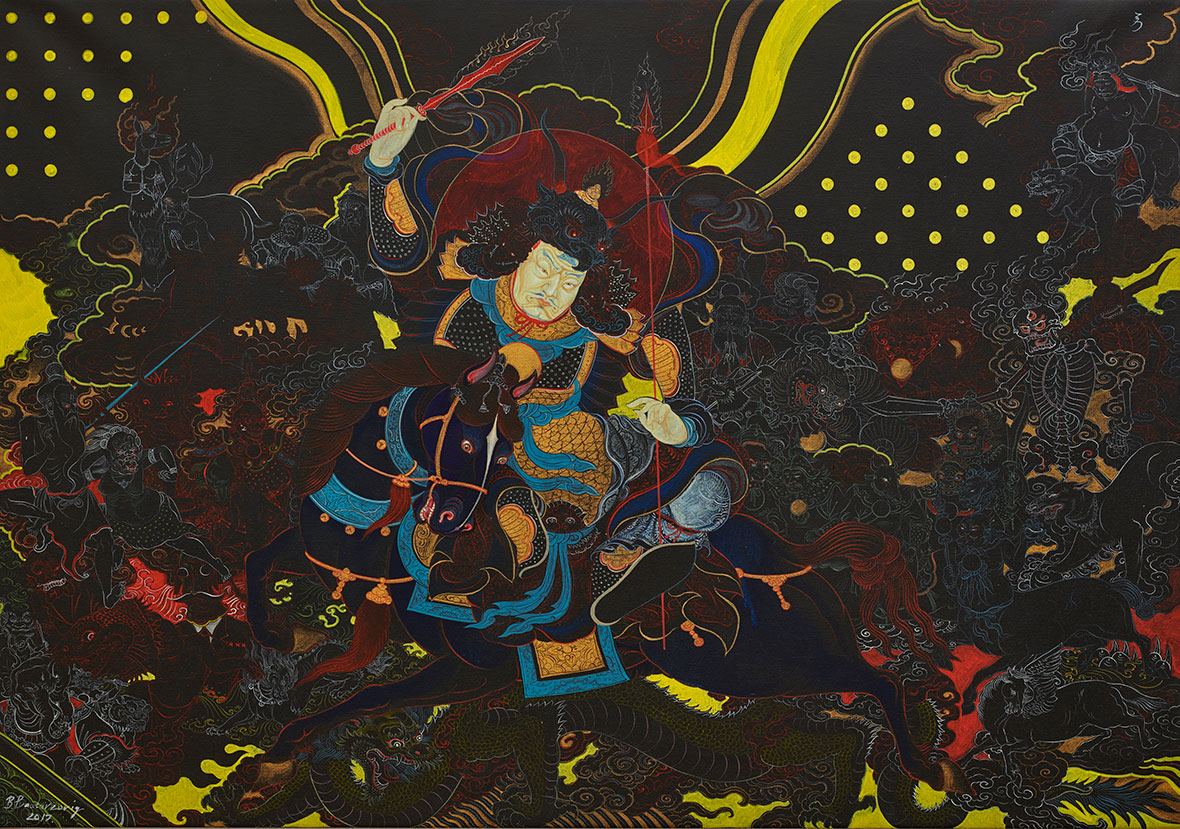
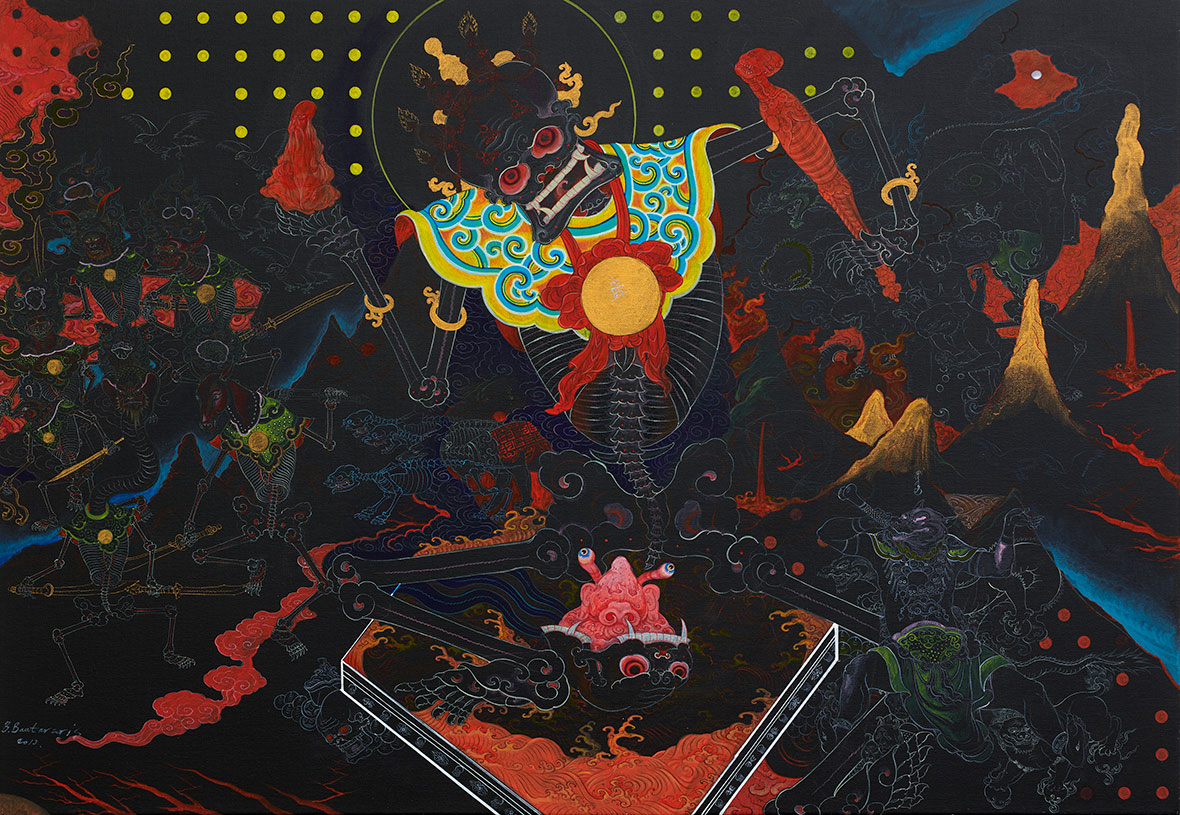
Born in 1983, Batjargal remembers his childhood under the centrally planned communist economy as a carefree time. “Everyone was going to work; kids were going to school, and, at the end of the day, everyone met at home for dinner,” he says, but he realizes that his childhood memories do not represent the whole reality of Mongolia under Soviets. “There were also too many problems. For instance, the state took people’s assets. This happened to relatives from my mother’s side a few times. The oppression levels were also very high, and many intellectuals were falsely accused of things. Some even died as a result,” he says.
Communism was what brought the first real wave of modernization to Mongolia, and the changes seriously affected the nomadic lifestyle. The regime made many decisions regarding the lives of the nomadic herders, restricting their mobility and even nationalizing their private livestock. As a result, communities were broken, and skills and costumes were lost.
Batjargal was still in secondary school when the communist regime fell in 1990, and, like most Mongolians, he knew little about democracy. Still, the side effects of the country’s transition into the capitalist system were rapidly visible, especially in the capital. “From 1990 to 2000, Ulaanbaatar felt almost like a collapsed gray city, full of chaos. Crimes were prevalent, and I could see many alcoholics, homeless, beggars, and orphans everywhere,” he remembers. On the bright side, Western products, like Coca-Cola, were readily available for the first time and, with satellite technology, Mongolian society opened to the world. “After 1990, different ideas and movements were introduced. I could watch channels such as MTV and many types of films,” Batjargal says.
Baatarzorig 出生于1983年,他的童年在计划经济下度过。记忆里,那是一段无忧无虑的时光。他回忆道:“大人都去工作,孩子都在上学。一天结束的时候,全家人会在一起吃晚饭。”但他意识到,自己的童年记忆并不能完全代表苏联统治下的蒙古。“问题也很多。国家拿走了平民百姓的资产。母亲那边的亲戚经历过几次这种事情。人们也会受到很严重的压迫,许多知识分子遭到了诬告,甚至有人因此失去生命,”他说。
共产主义为蒙古带来了第一波真正的现代化浪潮,这些变化严重影响了游牧生活方式。政府的决策让游牧民族的生活相应发生了许多改变,他们被限制四处流动,私有牲畜国有化。随之而来的结果是,原来的社区支离破碎,一些民族技艺和传统服饰也面临失传。
1990 年共产主义政权垮台,Baatarzorig 那会儿还在上小学,和大多数蒙古人一样,当时的他并不知道什么叫民主。尽管如此,蒙古过渡到资本主义制度的影响很快就显现出来,特别是在首都。“从 1990 年到 2000 年,乌兰巴托如同一座崩溃的灰暗城市,混乱不堪。犯罪现象日益猖獗,我常常看到许多酗酒的醉汉和无家可归者,满街都是乞丐和孤儿,”他回忆道。而变好的方面是,他们可以在蒙古买到可口可乐等西方产品;借助卫星技术,蒙古社会也向世界打开了大门。“1990 年后,不同的思潮和运动纷纷涌入蒙古。我可以看 MTV 等频道和各种类型的电影,”Baatarzorig 说。
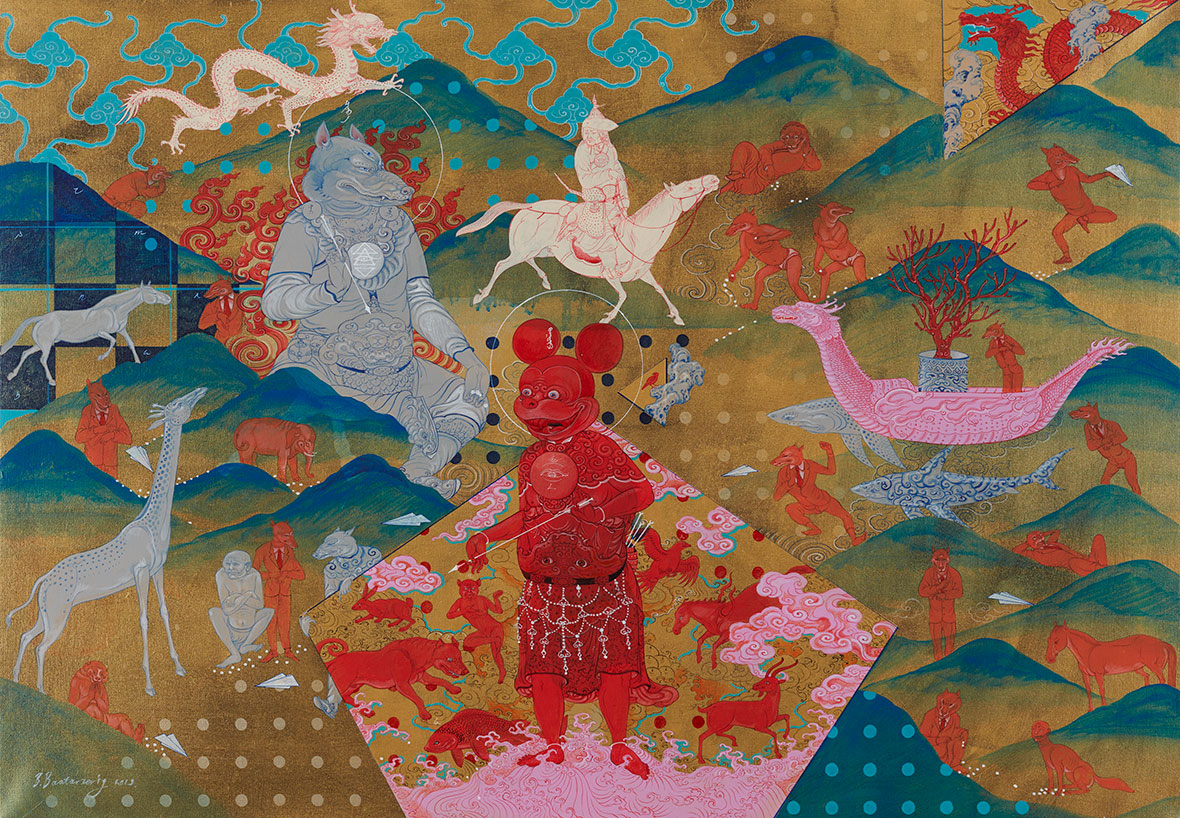
During the 1990s, many Mongolians who previously lived as nomads moved to brick apartments and houses in the city. And, since they could, some even carried their yurts. In the 2000s, it was common to see the white rounded tents assembled on the outskirts of Ulaanbaatar. The children of nomads began to aspire to blue or white color jobs—or else they wanted to become big stars. Even those who defied modernity and kept their nomadic lifestyle couldn’t help but let some of the technological advancements into their lives. The almighty horse was progressively replaced by motorcycles or jeeps, and satellite dishes became standard additions to yurts everywhere.
Mongolians became more exposed to the outside world than ever before through foreign TV. Batjargal grew up watching Disney cartoons, the well-known narratives that uphold American values, symbolized, above all, in one character: Mickey Mouse. “The reason I started drawing Mickey Mouse is that I watched it when I was a child. It was when Western culture came in quickly and with great power. Things that appear to be Western were highly valued. My memories of that time are tied to Mickey Mouse,” Batjargal says.
He sees the character as the most prominent cultural ambassador of the West, “a hero that spreads the Western culture in different places. Children and people everywhere see and learn this culture, lifestyle, and philosophies through it. If we think about it, Mickey Mouse is a character that transforms and changes. It’s easy to think of a Kazakh kid near the Altai Tavan Bogd Mountains wearing a Mickey Mouse t-shirt and of table cloths with Mickey Mouse patterns. Often you can find such things in the countryside of Mongolia, too. I think the same happens across Central Asia, Eastern Europe, and regions that used to follow the Soviet regime,” Batjargal says.
He even establishes an ironic parallel representing the worldwide indoctrination power of the happy rodent. “Mickey Mouse, in a trivial way, can be compared to the red star during the Soviet era, considering how widespread they both sank in,” he says. Batjargal’s depictions of Mickey Mouse are frightening. His version appears with glaring, crazy eyes and mischievous expressions, often taking the position of Buddhist deities across his paintings and several sculptures.
20 世纪 90 年代,许多蒙古游牧民搬到城市居住,在砖砌公寓和房屋里生活,有些人甚至带上了他们的蒙古包。2000 年代,经常可以看到人们在乌兰巴托郊区扎起白色的圆形帐篷。牧民的孩子开始向往蓝领或白领工作,有的人梦想成为明星。就连那些蔑视现代生活并保持游牧生活方式的人也忍不住在生活中享受科技的便利。马匹被摩托车或吉普车取而代之,卫星天线成为了蒙古包的标准配置。
通过外国电视,1990 年代的蒙古人接触到了比以往任何时候更丰富的外部世界。Baatarzorig 从小看迪士尼卡通长大,这些卡通片高举美国价值观,而米老鼠就是这些价值观的象征。他说:“我刚开始画米老鼠是因为这是我小时候看过的卡通片。那时候的西方文化迅速涌入,带来铺天盖地的影响,并显得格外珍贵。米老鼠就是我对那段时间的记忆。”
米老鼠对于 Baatarzorig 来说,就像是西方文化的代表,他接着说:“它像是一位使者,将西方文化传播至世界各地。世界各地的人们通过米老鼠认识西方文化、西方的生活方式和思想理念。米老鼠的出现让一切发生着转变,譬如在阿尔泰塔万博格德山脉附近,你可以看到穿着米老鼠 T 恤的哈萨克孩子和印着米老鼠图案的桌布。在蒙古乡村也能看到米老鼠的身影,而在中亚、东欧和其他曾经追随苏联政权的地区也发生着同样的变化。”
他甚至做了一个具有讽刺意味的类比,以表达米老鼠在全球的影响力。“米老鼠就像是苏联时代的红星,看似不起眼,却都有着潜移默化的作用,”他说道。Baatarzorig 笔下的米老鼠看上去面目可怖,露出了疯狂的眼神和淘气神情,且往往占据着绘画和雕塑中原属于佛教神灵的位置。
Another element that’s incongruous to the Mongolian landscape but that appears in his paintings is the figure of a shark, an intruding threat, like Mickey Mouse and the red star, swimming defiantly above it all, in a landlocked region. Curiously, Batjargal associates the shark with the British Navy and its predatory expansion over parts of the world. The animal is “the wolf of the water,” as he puts it, and “the predator of the sea.” The predator of the land would be the wolf; and of the air, the falcon. These three animals carry heavy military connotations, just like the camouflage patterns he sometimes includes, a direct allusion to the notions of power and aggression.
Batjargal likes to play with the dichotomy of predator and prey when depicting animals. Together with the various sharks, wolves, and falcons, we see many rabbits, which he reveals symbolize the nomads during the soviet era. “The rabbit is an animal that reproduces fast, but that is easy to manipulate,” he says. Another interesting recurrent element we see across his work is the red neck scarf, a clear nod to the Young Pioneers. From 1922 to 1991, this large youth organization amassed most children born in the Soviet Union and its satellite states, and one of its central doctrines was Marxist-Leninist atheism. The red scarf is a sign of indoctrination by the Soviets through youth education.
As we look attentively at Batjargal’s paintings, more and more elements emerge, most of them relating to the collapse of Soviet socialism and the arrival of Western capitalism in Mongolia, a mismatched assortment representing the collective stupor of a country torn between foreign ideologies. However, Batjargal notes he’s not criticizing any side. Naturally, he hints at dissatisfaction, but, above all, his work is a commentary on how everyone in the world is influenced by either one of these ideologies—or both simultaneously.
作品里另一种与蒙古风景格格不入的元素是鲨鱼,和米老鼠和红星一样,代表着入侵的威胁。充满挑衅的形象,大摇大摆地畅游于这个内陆国家之上。Baatarzorig 用鲨鱼来映射英国海军及其在世界部分地区的侵略扩张。正如他所说,这种动物是“海中之狼”,是“令人恐惧的掠食者”。加上陆地的狼和空中的猎鹰,这三种掠食者动物带着深厚的军事隐喻色彩,和他偶尔运用的迷彩图案一样,直接暗示权力与侵略的概念。
在描绘动物时,Baatarzorig 喜欢将掠食者与猎物处于相同的位置,在鲨鱼、狼和猎鹰的周围,还有着许多兔子。他解释这些兔子象征着苏联时代的游牧民族。他说:“兔子是一种繁殖速度快的动物,但很容易被操纵。”除此之外,他的作品里的另一个有趣的常见元素是红领巾,显然这是用来指代少先队。从 1922年到 1991 年,大多数在苏联及其卫星国出生的孩子都加入了这个大型青年组织。这个组织的核心学说之一是马列主义的无神论。而红领巾正是苏联政权通过青年进行教化的标志。
接着品味 Baatarzorig 的画作,你还会发现更多的元素。其中大多数都与苏联社会主义的崩溃和西方资本主义引入蒙古有关。错综复杂的元素代表了在各种外国意识形态的冲击下,以及人们的麻木和困惑。不过,Baatarzorig 指出,他无意批评任何一方。虽然他暗自表达了不满,但他在作品中更想表达的是,世界上每个人都无可避免受到其中一种或多种意识形态的影响。
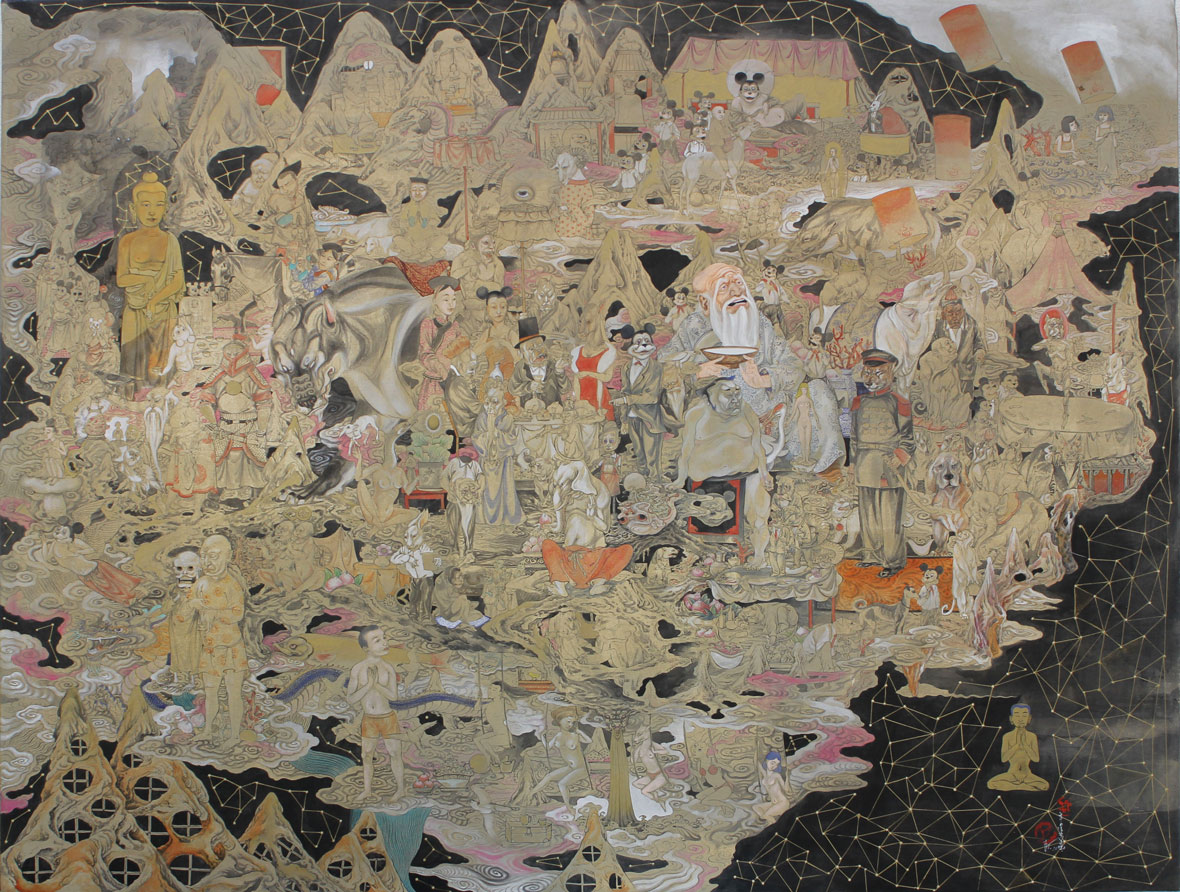
It’s not always easy to grasp Batjargal’s symbology or even the relationship between the elements he depicts. In fact, the meanings behind his works sometimes also evade him, the author. It doesn’t matter; clarity and realism are far from being his goal, and that’s one of his uniqueness when compared to other artists working on similar lines. “There are many artists who practice the Mongol zurag in Mongolia. I personally take direction in imaginary fields, things happening in our mind, instead of realism,” he explains.
And as he prepares for an upcoming solo show in London, his interest in the unconscious thoughts that take place inside the human mind has been only expanding. “Recently, I’ve been investigating the notions that, above all, exist in our minds but are not set in reality, such as the ideal worlds of communism, capitalism, or even religions like Buddhism, Islam, and Christianity,” he reveals.
His work is indeed infused with beliefs that define the Mongolian psyche. Across all of his pieces, just like Sharav’s One Day in Mongolia, Batjargal acknowledges the longstanding respect Mongolians have for nature. “Mongolians believed that the world is alive, offering the finest food, such as milk, to the spirits of the mountains, lakes, and the sun,” he says.
To Mongolians, nature is not only a means of subsistence but a source of spiritual fulfillment. Given the essence of this relationship, it’s not surprising that nomadic herders are ready to lift their base and even move livestock every time the natural environment around them changes.
Sadly, beyond authoritarianism and cultural invasion, nature has also become a threat to this lifestyle. Climate change and the effects of overgrazing for commercial purposes have been causing desertification in areas that were previously vital grasslands. As a result, more and more nomads abandon the countryside and flock to Ulaanbaatar—a city that already ranks as one of the world’s most polluted capitals—progressing their cultural demise.
在观众眼中,Baatarzorig 作品中的符号意义或是他笔下各种元素之间的联系并不总是那么明了。有时候,作品背后的意义也会超出创作者的意图。但这并不重要,因为清晰的寓意和写实主义远非他的目标,而这也是他与其他祖拉格艺术家的不同之处。他解释道:“蒙古有许多创作祖拉格的艺术家。我个人更倾向于抽象的创作方向,譬如描绘内心的想法,而不是写实主义。”
在他筹备即将在伦敦举行的个展期间,他对人们内心无意识的想法愈发感兴趣。他说:“最近,我一直在研究那些存在于人们脑海里但尚未成为现实的观念,例如共产主义、资本主义,甚至是佛教、伊斯兰教和基督教等宗教描绘的理想世界。”
就像是他的作品也同样体现了蒙古人内心的信仰。正如 Baldugiin Sharav 那幅经典的《蒙古的一天》,Baatarzorig 的所有作品都传达出蒙古人自古以来对自然的敬仰。他说:“蒙古人相信世界是有生命的,为山脉、湖泊和太阳的神灵供奉上牛奶等各种食物。” 对蒙古人来说,自然不仅是一种生存手段,更是精神食粮的源泉。在这层关系下,每当周围的自然环境发生变化,游牧的牧民都会毫不犹豫地带上他们的牲畜,举家搬迁。
令人感到可悲的是,除了集权主义和文化入侵之外,大自然也成为这种生活方式的威胁。在气候变化和商业化导致的过度放牧的影响下,原本生机勃勃的草原地区逐渐荒漠化。结果,越来越多的游牧民族放弃农村,涌向乌兰巴托——一个已经被列为世界上污染最严重的首都城市之一,而这又进一步加速了其传统文化的消亡。
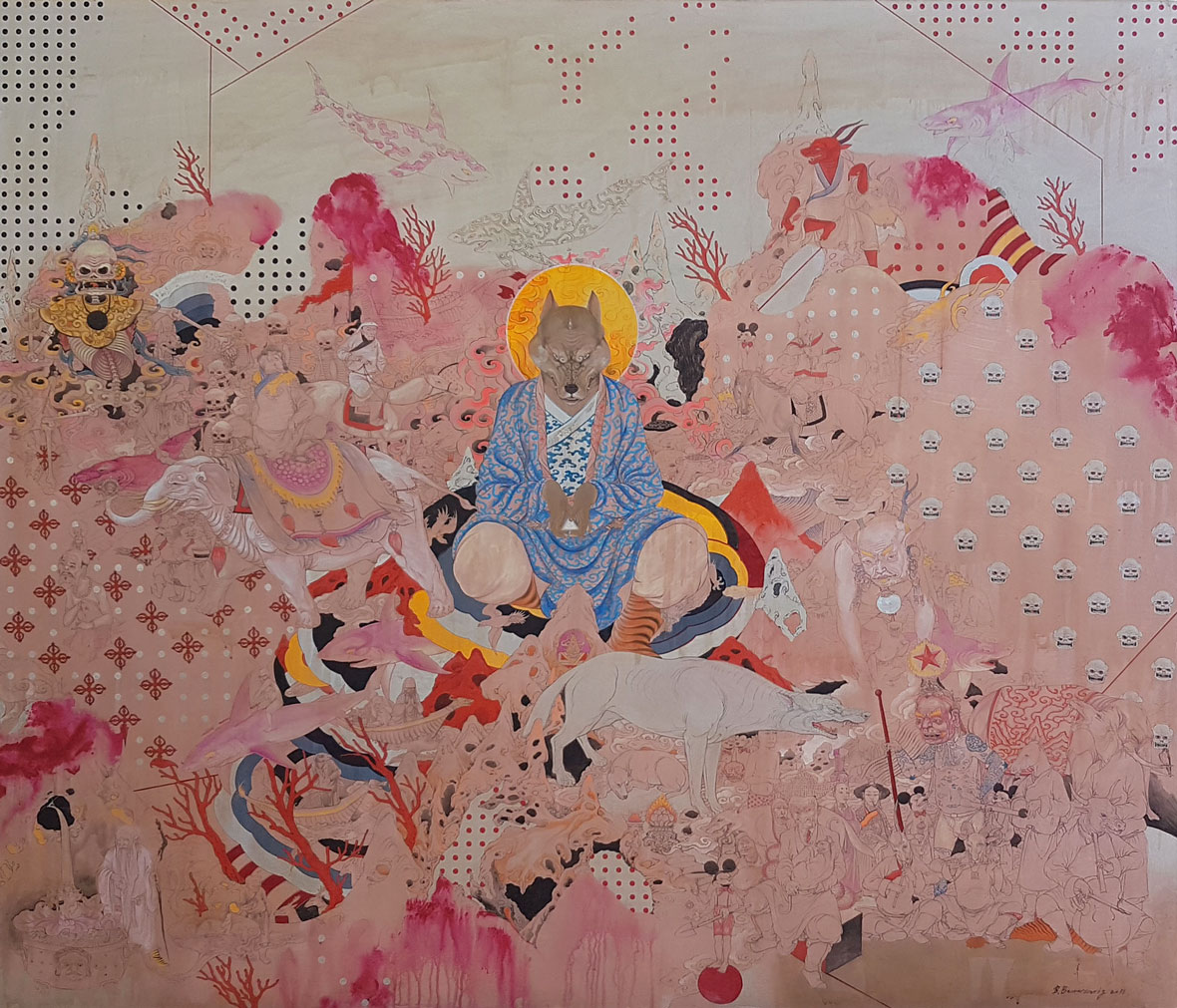
Batjargal believes that the phenomenon of cultural extinction is analogous to what we see in animal extinction. He points out that customs and traditions of indigenous people are disappearing in the same fashion that some animal species are also going extinct—both because of the impacts of modern life. To him, the solution is to revisit the origins and reclaim the ancient, quintessential philosophies in which Mongolian society is rooted to pass them on to the newer generations before they disappear forever.
“Mongolians have always had a deep relationship with nature, and the philosophy of life has always been living in harmony with nature,” he says. “It’s a philosophical question of how we coexist with these distinct entities—the creatures in nature, the earth, the sky. As an artist, I strive to put these into my works to pass down this idea of coexistence with nature to the new generation.”
Batjargal’s powerful message resonates beyond Mongolia. Loss of heritage is a global issue, and he’s aware of that. With the growing international attention his work has been receiving, he’s thrilled to see his message reaching a broader audience. “Nowadays, my works are presented in international biennales and are getting recognized abroad. Art is a language without a need for translation. Through this language, my ideas reach many people regardless of where they are from,” he says.
Baatarzorig 认为,文化灭绝类似于动物灭绝,原住民的习俗和传统正在消失,与物种的消亡一样——罪魁祸首都是现代生活的影响。他认为要解决这个问题,就要重新审视文化根源,恢复蒙古社会所扎根的那些古老而根本的哲学理念,在它们永远消失之前将其传递给下一代人。
他说:“蒙古人一直与自然保持深厚联系,其生活理念一直是与自然和谐相处。这是一个关于我们如何与世间万物共存的哲学问题,包括自然界中的生物、地球和天空。作为艺术家,我努力在作品中融入这一切,将这种与自然共存的理念传递给下一代人。”
在蒙古地区之外,Baatarzorig 强有力的作品产生了更多共鸣。传统文化的消亡是一个全球性问题。随着他的作品在国际社会引发关注,他很高兴看到埋藏在作品中的理念能传达到更广泛的群体。他说:“我的作品在国际双年展上展出,也得到了国外观众的认可。艺术是一种不需要翻译的语言。通过这种语言,我可以将自己的想法传达给更多来自世界各地的人。”
Like our stories? Follow us on Facebook and Instagram.
Instagram: @baatarzorigbatjargal
Contributor: Tomás Pinheiro, Lucas Tinoco
Chinese Translation: Olivia Li
Mongolian Translation: Purev Batdelger
Images Courtesy of Baatarzorig Batjargal & Jack Bell Gallery
Instagram: @baatarzorigbatjargal
供稿人:Tomás Pinheiro, Lucas Tinoco
英译中: Olivia Li
蒙译英: Purev Batdelger
图片由 Baatarzorig Batjargal 与 Jack Bell Gallery 提供


